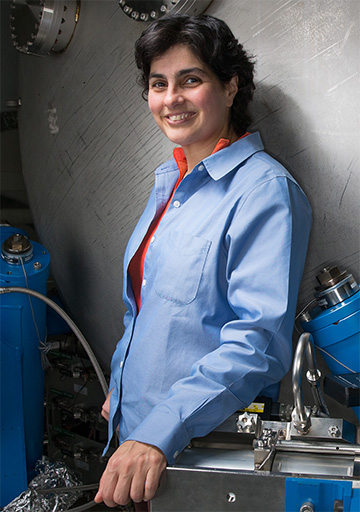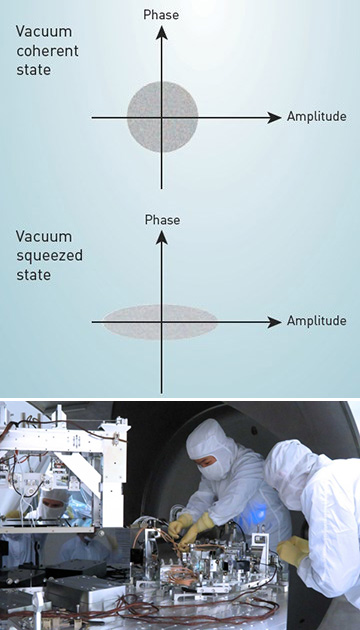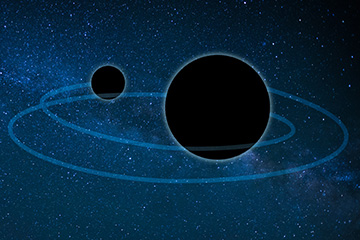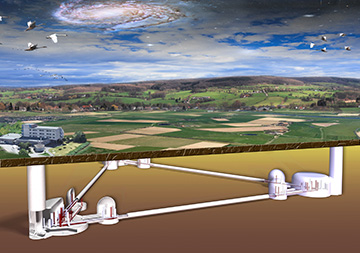
Nergis Mavalvala. [Image: news.mit.edu]
On the second day of the Frontiers in Optics+Laser Science virtual meeting, OSA Fellow Nergis Mavalvala of the Massachusetts Institute of Technology (MIT), USA, delivered the first of the meeting’s two plenary addresses. Her subject was some recent, remarkable improvements to the sensitivity of the already mind-bendingly precise LIGO and Virgo laser-interferometer gravitational-wave observatories.
In particular, Mavalvala covered the most recent round of upgrades to the facilities, which ratcheted up their sensitivity by injecting so-called squeezed light into the interferometer to reduce noise attributable to quantum vacuum fluctuations. Mavalvala talked with OPN about her own road in gravitational-wave science, and what’s ahead, after her plenary address.
You’ve been involved with in this area for almost 30 years now. When you first got started, were you actually looking to work on gravitational waves? Or did this area sort of “find you”?
Nergis Mavalvala: I would say it didn’t “find me”; I found it. But I had never even heard about a gravitational wave until I met Rainer Weiss. I was starting my graduate career at MIT, and I was looking for a group to join and kind of wandered into his office—and he was the first one to tell me about gravitational waves.
Those struck me as mysterious and interesting. But the thing that really hooked me into walking this long journey with him, and then beyond, was the precision of the measurement. I thought it was insane—but also insanely exciting—to try to make a measurement that’s this precise, to measure displacements at the attometer scale.
And the other thing that has really stayed with me my whole career was that when gravitational waves finally were discovered, it really would be a completely different way to look at the universe. So I was really taken in by the precision measurement and the technology, but the scientific rewards were also great.
It wasn’t until 25 years after you started that the first gravitational-wave detection was announced. That is a very long timeline—it seems like it must be challenging to “keep the faith” over such a long period.
Yes and no! Certainly, I would say that there were as many moments of despair as any other endeavor would have had. But they were not on the big picture—the question of “Will we ever detect these waves?” They were on the smaller scale—“Oh, my goodness, my circuit doesn't work,” or “Oh, here’s another mirror that doesn't meet spec.” Those kinds of things.
You know, there’s this idea out there that from the time of LIGO’s conception to the time that the discoveries were made, there was this desert of results. And that's really not true—we were innovating the whole time! You’re not going to get funded for decades for producing nothing but promises.
So there were always milestones, benchmarks, publications. Even though the discovery of gravitational waves hadn’t come yet, the field, especially on the instrumentation and precision-measurement side, was very vibrant.

Top: In a squeezed state of light, nonlinear optical techniques are used to reduce the Heisenberg uncertainty associated with one quadrature of the light field (for example, phase) by transferring some of it to the other quadrature (amplitude). Bottom: LIGO team members install equipment for squeezed-light upgrade, to reduce quantum noise in the interferometer. [Image: Top, Alessia Kirkland; bottom, LIGO/Caltech/MIT/Matt Heintze]
Let’s talk a bit about the subject of your of the FiO+LS plenary talk—the use of “squeezed light” to push the sensitivity of the LIGO and Virgo observatories even further, by reducing noise from quantum fluctuations. This idea was first floated in the late 1970s, before the first LIGO was even built. Why did it take so long to have this technique become part of these observatories?
There were a couple of things going on. The most important was the technological barriers. In the early years there were a handful of proof-of-principle experiments on tabletop setups. But after that things went pretty quiet for a while, because the technology just wasn’t in place to make them useful for LIGO.
When you are trying to make a sub-quantum-noise measurement, your lab already needs to be at the quantum noise limit, and that’s really hard to do—especially at the 100-Hz frequency band at which LIGO operates. The whole world is very jittery at those frequencies, and the lasers were not quantum noise limited.
So the whole squeezing idea was at a very low level of activity until the early 2000s, when the Advanced LIGO design—the one that eventually succeeded in detecting gravitational waves—had been conceptualized. At that time we saw that we were at the quantum noise limit. And we knew that if we wanted to go further, we would want to use these quantum technologies, such as squeezed states of light. The need suddenly grew; we knew that there were no other knobs we could easily turn to boost sensitivity further.
The payoff for that effort was phenomenal, though—in your talk, you noted that in the third LIGO/Virgo observation run, after the squeezed-light capability was installed, the frequency of discoveries increased from around one event a month to one a week, with new kinds of events being detected, too.
Yes. We’ve calculated that a significant part of the increase was due to the injection of squeezed light in the detector to reduce quantum noise. The rest of came from a number of other improvements—increasing the laser power; replacing some lossy optics; mitigating some low-frequency noise that came from scattered light. But the use of squeezed light was the biggest chunk.

The sensitivity increases in the most recent upgrade of the LIGO and Virgo facilities—including the capability to inject squeezed states of light to reduce quantum noise— contributed to a raft of new detected events, including a “lopsided” collision of two black holes with dramatically different masses. [Image: MIT News]
And the next step, as you noted in your talk, is to do “frequency-dependent squeezing,” to reduce not just shot noise at high detector frequencies, but the quantum radiation pressure noise at the interferometer mirrors at low frequencies.
Yes. That’s being implemented now, for the next observation run, which is slated to start more than a year from now, though we don't fully know what impact COVID-19 will have on that.
Let’s talk just for a moment about the road ahead for these laser-interferometer gravitational-wave observatories. Japan’s KAGRA facility became operational last year, and LIGO–India is planned to come online in the mid-2020s. What is it going to mean to have five large Earth-based gravitational-wave observatories operating?
Gravitational wave detectors are not very directional; we can’t really tell where the signal is located in the sky with a single detector. The more detectors, the larger your baseline is and the better your triangulation becomes. So to localize where sources are, you would like a network of detectors.
And you really do want to localize those sources. Because if you want to follow up gravitational-wave observations with telescopes—to do “multimessenger astronomy” and put gravitational-wave and light-wave observations together—telescopes have very small fields of view. You need to be able to pinpoint where a telescope should look.
At the end of your talk, you touched on a few projects still on the drawing boards—including “third-generation” projects like the European Einstein Telescope, which would have interferometer arms 10 km long, and a concept led by U.S. researchers, Cosmic Explorer, which envisions a laser interferometer with 40-km arms. How “real” are these projects?

The Einstein Telescope, a “third-generation” gravitational-wave detector now in the design phase in Europe, envisions laser interferometer arms 10 km in length. [Image: Marco Kraan, Nikhef]
That’s a fair question. In terms of the technical feasibility they’re as real as they can be, with respect to laying the groundwork without serious funding and big production—though I will say that the National Science Foundation has, for example, put some real funding into developing the concept for Cosmic Explorer. So technically, they’re pretty realistic.
But whether these will emerge as a significant enough investment priority for the U.S., and indeed many nations, is a different question. I would argue that this is one of the most exciting things that we could be doing. But priorities and funding are complicated.
If they are funded, what sort of things might these third-generation facilities be able to find?
Well, for example, as I mentioned in my talk, for collisions of 30-solar-mass black holes, we would be able to see these events out to a redshift of 10—which means, basically, that we would be able to map out all of those events in the observable universe. That’s remarkable. For neutron-star collisions, we’d be able to see all events out to a redshift of six, which still captures many, many populations of these stars.
Why do we want to see each and every one? Because the ones that we see further out are going to tell us about the history of their formation and, in some sense, the history of the formation of the universe. So it’s not just about seeing every single one that’s in our “neighborhood” in the universe—it’s about seeing further out, so you can get the sense of whether these kinds of things were the same at the beginning, and what the differences might be.
Another much-coveted source of gravitational waves, which we haven’t yet seen, is supernovae. It turns out that the current generation of gravitational-wave detectors are mostly sensitive to supernovae that would happen in our own galaxy—and since there’s roughly one supernova per hundred years in any one galaxy, the chances of seeing a good sample is not very great. With these larger, third-generation interferometers, it’s thought that you might see 20 supernovae per year.
There are many other things we could talk about—cosmological tests that can be done; searching for primordial black holes, born out of quantum fluctuations, that some have suggested may have populated the early universe. And, of course, the things we haven’t even thought of yet—every major new instrument in astronomy has revealed things we didn't even know existed. I can't imagine that gravitational waves won't have a few of those surprises as well.
